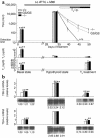Thyroid hormone action in the absence of thyroid hormone receptor DNA-binding in vivo
- PMID: 12925699
- PMCID: PMC171393
- DOI: 10.1172/JCI18377
Thyroid hormone action in the absence of thyroid hormone receptor DNA-binding in vivo
Abstract
Thyroid hormone action is mediated by thyroid hormone receptors (TRs), which are members of the nuclear hormone receptor superfamily. DNA-binding is presumed to be essential for all nuclear actions of thyroid hormone. To test this hypothesis in vivo, the DNA-binding domain of TR-beta was mutated within its P-box (GS mutant) using gene targeting techniques. This mutation in vitro completely abolishes TR-beta DNA-binding, while preserving ligand (T3) and cofactor interactions with the receptor. Homozygous mutant (TR-betaGS/GS) mice displayed abnormal T3 regulation of the hypothalamic-pituitary-thyroid axis and retina identical to abnormalities previously observed in TR-beta KO (TR-beta-/-) mice. However, TR-betaGS/GS mutant mice maintained normal hearing at certain frequencies and did not display significant outer hair cell loss, in contrast to TR-beta-/- mice. DNA-binding, therefore, is essential for many functions of the TR, including retinal development and negative feedback regulation by thyroid hormone of the hypothalamic-pituitary-thyroid axis. Inner ear development, although not completely normal, can occur in the absence of TR DNA-binding, suggesting that an alternative and perhaps novel thyroid hormone-signaling pathway may mediate these effects.
Figures





Comment in
-
Thyroid hormone action: a binding contract.J Clin Invest. 2003 Aug;112(4):497-9. doi: 10.1172/JCI19479. J Clin Invest. 2003. PMID: 12925689 Free PMC article. Review.
Similar articles
-
Negative regulation by thyroid hormone receptor requires an intact coactivator-binding surface.J Clin Invest. 2005 Sep;115(9):2517-23. doi: 10.1172/JCI24109. Epub 2005 Aug 11. J Clin Invest. 2005. PMID: 16100573 Free PMC article.
-
Thyroid hormone action: insight from transgenic mouse models.J Investig Med. 2003 Jul;51(4):215-20. doi: 10.1136/jim-51-04-22. J Investig Med. 2003. PMID: 12929737 Review.
-
Dominant inhibition of thyroid hormone action selectively in the pituitary of thyroid hormone receptor-beta null mice abolishes the regulation of thyrotropin by thyroid hormone.Mol Endocrinol. 2003 Sep;17(9):1767-76. doi: 10.1210/me.2003-0109. Epub 2003 Jun 20. Mol Endocrinol. 2003. PMID: 12819298
-
A homozygous deletion in the c-erbA beta thyroid hormone receptor gene in a patient with generalized thyroid hormone resistance: isolation and characterization of the mutant receptor.Mol Endocrinol. 1991 Mar;5(3):327-35. doi: 10.1210/mend-5-3-327. Mol Endocrinol. 1991. PMID: 1653889
-
Isoform-dependent actions of thyroid hormone nuclear receptors: lessons from knockin mutant mice.Steroids. 2005 May-Jun;70(5-7):450-4. doi: 10.1016/j.steroids.2005.02.003. Epub 2005 Mar 16. Steroids. 2005. PMID: 15862829 Review.
Cited by
-
Thyroid hormones inhibit TGF-β signaling and attenuate fibrotic responses.Proc Natl Acad Sci U S A. 2016 Jun 14;113(24):E3451-60. doi: 10.1073/pnas.1506113113. Epub 2016 May 31. Proc Natl Acad Sci U S A. 2016. PMID: 27247403 Free PMC article.
-
Dissecting the Relation between a nuclear receptor and GATA: binding affinity studies of thyroid hormone receptor and GATA2 on TSHβ promoter.PLoS One. 2010 Sep 7;5(9):e12628. doi: 10.1371/journal.pone.0012628. PLoS One. 2010. PMID: 20838640 Free PMC article.
-
Exacerbated age-related hearing loss in mice lacking the p43 mitochondrial T3 receptor.BMC Biol. 2021 Feb 1;19(1):18. doi: 10.1186/s12915-021-00953-1. BMC Biol. 2021. PMID: 33526032 Free PMC article.
-
Noncanonical thyroid hormone signaling mediates cardiometabolic effects in vivo.Proc Natl Acad Sci U S A. 2017 Dec 26;114(52):E11323-E11332. doi: 10.1073/pnas.1706801115. Epub 2017 Dec 11. Proc Natl Acad Sci U S A. 2017. PMID: 29229863 Free PMC article.
-
Thyroid Hormone Action by Genomic and Nongenomic Molecular Mechanisms.Methods Mol Biol. 2025;2876:17-34. doi: 10.1007/978-1-0716-4252-8_2. Methods Mol Biol. 2025. PMID: 39579306
References
-
- Brent GA. The molecular basis of thyroid hormone action. N. Engl. J. Med. 1994;331:847–853. - PubMed
-
- Oppenheimer JH, Schwartz HL. Molecular basis of thyroid hormone-dependent brain development. Endocr. Rev. 1997;18:462–475. - PubMed
-
- Koibuchi N, Chin WW. Thyroid hormone action and brain development. Trends Endocrinol. Metab. 2000;11:123–128. - PubMed
-
- Cohen, R.C., Weintraub, B.D., and Wondisford, F.E. 2000. Chemistry and biosynthesis of thyrotropin. In Werner and Ingbar’s The thyroid: a fundamental and clinical text. 8th edition. L.E. Braverman, and R.D. Utiger, editors. Williams & Wilkins. Baltimore, Maryland, USA. 202–218.
-
- Forrest D, Erway LC, Ng L, Altschuler R, Curran T. Thyroid hormone receptor beta is essential for development of auditory function. Nat. Genet. 1996;13:354–357. - PubMed
Publication types
MeSH terms
Substances
Grants and funding
LinkOut - more resources
Full Text Sources
Other Literature Sources
Molecular Biology Databases
Research Materials

